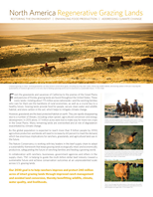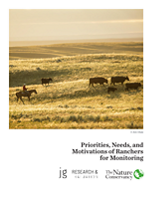Regenerative Grazing Lands
Livestock grazing on intact, working grasslands can help secure clean water, enhance habitat, address climate change and sustain rural communities.
From the grasslands and savannas of California to the prairies of the Great Plains and pastures of Florida, grazing lands are found throughout the United States. These iconic lands—totaling about 775 million acres nationwide—and the ranching families who care for them are the backbone of rural economies, as well as a crucial key to a healthy future. Grazing lands provide food for people, secure clean water and wildlife habitat, and store carbon in the soil, which helps to mitigate climate change.
However, grasslands are the least protected habitat on earth. They are rapidly disappearing due to a number of threats, including urban sprawl, agricultural conversion and energy development. In 2015 alone, 3.7 million acres were lost to make way for more row crops in the Great Plains. Many remaining lands are overworked and at risk of degradation exacerbated by climate change.
The Nature Conservancy is working with ranchers and other key leaders in the beef supply chain to adopt a sustainability framework that keeps grasslands ecologically intact and economically productive, safeguarding the future of ranching families and feeding a growing world.
Our goal is to improve management on 240 million acres (30%) of U.S. grazing lands by 2030, resulting in enhanced wildlife habitat, soil carbon storage, water quality, and rural economies.
To achieve this goal, we are working with ranchers and the beef supply chain to conserve intact grasslands and ensure our nation’s grazing lands benefit from improved management practices to conserve natural resources, while producing food and sustaining ranching communities.
Growing Collaborations, Resources and Science
Our goal to effect long-term change within the beef industry is ambitious and our window to achieve it is small. To do so, we are collaborating in new and innovative ways across business, science and policy sectors.
Specifically, TNC is working with diverse partners to:
- Provide producers and ranch advisors with innovative tools and resources to develop and implement sustainable management plans;
- Foster private and public partnerships to rapidly scale up the adoption of sustainable grazing practices;
- Launch pilot projects to identify, test and promote science-based sustainable grazing practices; and
- Align corporate and government policies and programs to support land managers seeking to improve their ecological, social and economic outcomes.
These strategies will expand the collaborations, resources and science needed to achieve sustainability at a scale that is meaningful for the people, wildlife and the natural communities that depend on healthy grazing lands.
Together, We Can Make a Difference
The Nature Conservancy—which owns 500,000 acres of U.S. grazing lands and has helped to conserve millions more through easements and collaborative management—has worked for years to develop strong, trusting relationships within the ranching community and the beef supply chain. We use our lands to work with and support neighboring ranchers and to develop and test cutting-edge, science-based management practices.
Food companies and other supply chain stakeholders are seeking TNC’s expertise to achieve sustainability goals while driving accountability within the industry, positioning our staff to help guide national initiatives that have the potential to make a lasting impact.
We are at a critical moment in time. Grazing has the largest footprint of any agricultural activity, making it imperative that we manage these lands for clean water, climate benefits, global food security and vibrant rural communities. Together, we can help safeguard an enduring part of America’s heritage while protecting natural resources and ensuring a sustainable future for a growing world.
Proven Success
Supply Chain
TNC is helping some of the world’s largest purchasers of beef take proactive steps to achieve sustainability within their supply chains, including supporting producers in the widespread adoption of regenerative practices. Our work with McDonald’s and Walmart, for instance, led TNC scientists to develop a roadmap to help other companies identify opportunities, make supply chain improvements, and track progress toward their sustainability goals.
Sustainability Goals
TNC is a founding member of the U.S. Roundtable for Sustainable Beef (USRSB), an initiative to advance sustainability in the beef industry. In spring 2022 the USRSB launched sustainability goals for the nation’s beef supply chain to help producers and industry bring the most sustainable beef products to market.
TNC provided scientific expertise to the development of the goals, ensuring conservation priorities—ecosystem health, water quality and quantity, and reduced GHG emissions—are prioritized outcomes. Read TNC’s statement about the sustainability goals.
Collaborative Research
TNC and partners launched a 5-year project in 2022 at three working ranches to research how virtual fencing can help managers improve soil carbon storage, biodiversity, and economic outcomes. Virtual fencing is an innovative technology that enables the precise control of cattle movement.
At scale, virtual fencing may unlock the use of practices that regenerate land health and help address climate change and biodiversity loss.
Download Our Fact Sheet
-
 Regenerative Grazing Lands
Regenerative Grazing LandsSee how we're using science and collaboration to achieve success.
DOWNLOAD
Download Planning Guide
-
 Ranch Management Planning Guide
Ranch Management Planning GuideEssentials for ensuring long-term sustainability of ranch operations.
DOWNLOAD
Download Ranch Monitoring Report
-
 Priorities, Needs, and Motivations of Ranchers for Monitoring
Priorities, Needs, and Motivations of Ranchers for MonitoringAnalysis of the priorities, needs, and motivations of ranchers regarding monitoring sustainability indicators.
DOWNLOAD





